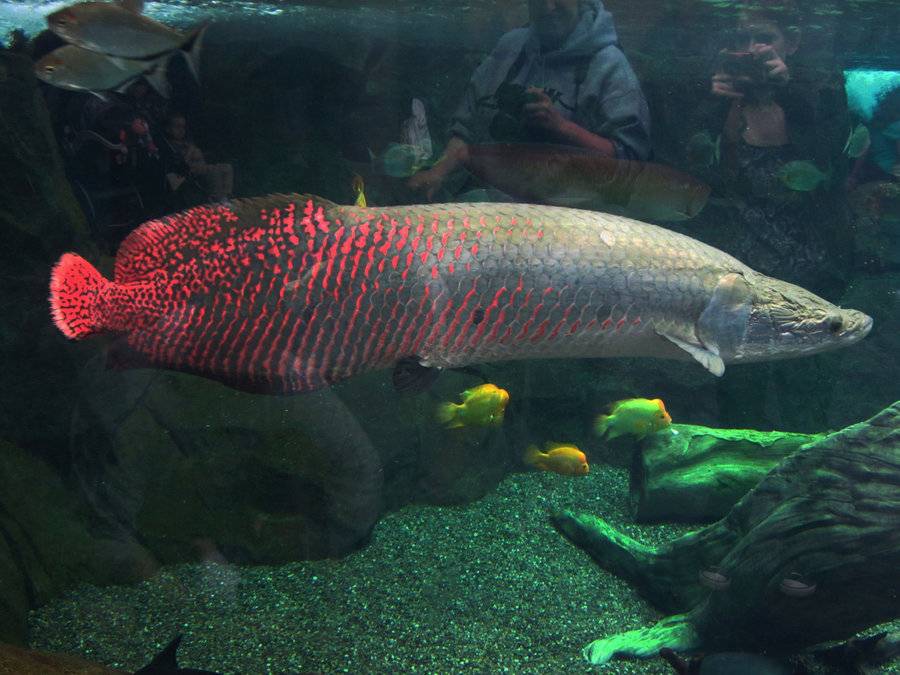The Amazon rain forest is an immense ecosystem, providing a habitat for creatures as weird and wonderful as the jaguar, the poison dart frog and the Jesus lizard. But it’s home to more than just the animals that prowl, swing, and slither through the trees. In the depths of the Amazon River, the largest river in the world, live creatures so amazing and so terrifying, that they make Jawslook like a nice, relaxing swim in the ocean.
 Oh, and yes, they totally attack humans. In 2010, a biologist named Deise Nishimura was attacked by a caiman while cleaning a fish on her houseboat, and while she managed to fight it off, it tookone of her legs with it. This particular caiman had been living under her houseboat for eight months, evidently waiting for the chance to strike.
Oh, and yes, they totally attack humans. In 2010, a biologist named Deise Nishimura was attacked by a caiman while cleaning a fish on her houseboat, and while she managed to fight it off, it tookone of her legs with it. This particular caiman had been living under her houseboat for eight months, evidently waiting for the chance to strike.










 As National Geographic previously reported, freshwater stingrays are known to inhabit rivers in Southeast Asia and northern Australia, where they can reach enormous proportions, measuring up to 16.5 feet long and up to 1,320 pounds.
As National Geographic previously reported, freshwater stingrays are known to inhabit rivers in Southeast Asia and northern Australia, where they can reach enormous proportions, measuring up to 16.5 feet long and up to 1,320 pounds.
Black Caiman
A black caiman is basically an alligator on steroids. They can grow up to six meters (20 feet) long, with bigger, heavier skulls than Nile crocodiles, and are the apex predator in the Amazonian waters. That means they are basically the kings of the river—they eat nearly anything they can get their teeth into, including piranhas, monkeys, perch, deer, and anaconda. Oh, and yes, they totally attack humans. In 2010, a biologist named Deise Nishimura was attacked by a caiman while cleaning a fish on her houseboat, and while she managed to fight it off, it tookone of her legs with it. This particular caiman had been living under her houseboat for eight months, evidently waiting for the chance to strike.
Oh, and yes, they totally attack humans. In 2010, a biologist named Deise Nishimura was attacked by a caiman while cleaning a fish on her houseboat, and while she managed to fight it off, it tookone of her legs with it. This particular caiman had been living under her houseboat for eight months, evidently waiting for the chance to strike.
Green Anaconda
Continuing with the theme of gigantic reptiles, the largest snake in the world makes its home in the Amazon: the anaconda. While reticulated pythons are actually longer, green anaconda are far heavier; the females, generally larger than males, can reach 250 kilograms (550 lbs), grow to nine meters (over 29 feet) long and reach 30 centimeters (12 in) in diameter.
Diving Bell Spider
The diving bell spider is the only known spider in the world that lives entirely underwater. Like other arachnids, it must breathe air, but it provides its own supply by forming a bubble, which it holds by hairs on its legs and abdomen. The spiders must occasionally return to the surface to replenish their air supply, although some gas exchange happens across the surface of their bubbles, so they don't have to come up very often.
Giant Catfish
Divers work with a model European catfish in the Great Lake at Ostersund in Sweden. Large catfish live in many rivers throughout the world, where they are important scavengers. The largest on record is the Mekong giant catfish, which has reached recorded sizes up to 10.5 feet and 660 pounds.
Arapaima
Arapaima, also known as “pirarucu” or “paiche,” are gigantic carnivorous fish that live in the Amazon and surrounding lakes. Encased in armored scales, they think nothing of living in piranha-infested waters—and they are pretty effective predators themselves, feeding on fish and the occasional bird.
Bull Sharks
While technically ocean-dwelling saltwater animals, bull sharks are quite at home in fresh water, too—they have been found as far down the Amazon as Iquitos in Peru, almost 4,000 kilometers (2,500 mi) from the sea. They have special kidneys that can sense the change in salinity of the surrounding water and adapt accordingly.
Payara
Anything with the name “vampire fish” should automatically be recognized as scary, and payara are no exception. They are absolutely ferocious predators, capable of devouring fish up to half their own body size. Given that they can grow up to 4 feet long, this is no mean feat.
Electric Eels
Electric eels are actually more closely related to catfish than eels, but you probably wouldn’t want to get close enough to one to find out. They can grow up to 8 feet long and can produce jolts of electricity from specialized cells called electrocytes arranged down their flanks.
Pacu
One animal certain to be far more terrifying to men than to women, the pacu is a much largerrelative of the piranha, known for its distinctive, human-like teeth.
Nile Crocodile
A year-old Nile crocodile attempts to snap up a frog in the St. Lucia Estuary in South Africa. Also known as the common crocodile, these large reptiles are distributed across much of Africa.
Mata Mata
A mata mata is a freshwater turtle that inhabits the Amazon and Orinoco basins in South America. The bizarre turtles are entirely aquatic, although they prefer shallow, stagnant water, where they can easily reach their head out of water to breathe.
Giant Freshwater Stingray















